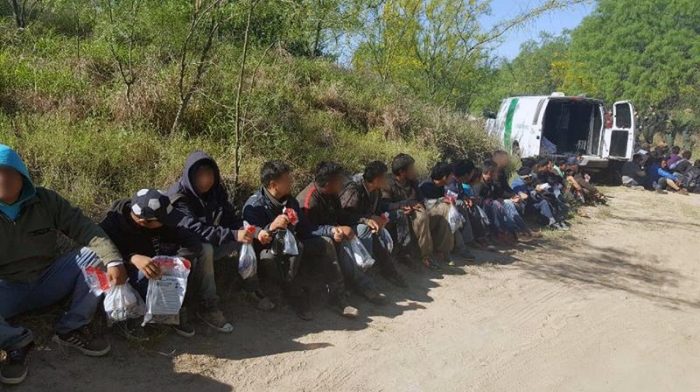By Casey Harper (Center Square)
At least 156,274 people entered the U.S. illegally in January, down 40% from 251,978 in December 2022, according to U.S. Customs and Border Protection data released Friday. This data refers to individuals who are known and reported to have illegally entered ports of entry, to avoid capture by law enforcement, and not to return to Mexico or Canada.
In December, at least 87,631 getaways were reported in nine southern border sectors, according to data obtained by The Center Square from Border Patrol agents. The agent gave the information on condition of anonymity for fear of reprisal; It includes only Border Patrol data and excludes Office of Field Operations data.
In January, the highest numbers were reported in the El Paso and Del Rio sectors of Texas at nearly 60,000. According to the data, the combined number of apprehensions and strays in January was at least 215,998.
“The January monthly operational update clearly indicates that the new border enforcement measures are working, with the lowest level of Border Patrol encounters at ports of entry since February 2021,” said CBP Acting Commissioner Troy Miller. This trend continued into February, with average encounters of Cubans, Haitians, Nicaraguans and Venezuelans.”
According to CBP data, the monthly number is about 303,916 apprehensions for the nine Southwest sectors reported in fiscal year 2017, excluding Gotaway. The monthly total for January is higher than the total for each fiscal year since the 1970s and 1960s, when the Border Patrol began reporting data by sector.
Since President Biden took office, monthly apprehensions of illegal aliens have exceeded the minimum 150,000 for 23 consecutive months, including holidays last November and December, when totals exceeded 300,000 each.
Texas continues to crack down on illegal entry, with the El Paso and Del Rio sectors seeing the heaviest traffic, according to preliminary Border Patrol data obtained by The Center Square.
As of February 2, preliminary data for January by sector includes:
Big Bend Sector
Apps – 1,274
TB-55
Gotaways Border Zone (Known/Recorded)- 631
Classifiable Identification – 11
Gotaways Interior Zone- 78
No violation- 10
Dead – 0
Outstanding – 128
Del Rio Sector
Apps – 28,806
TB- 236
Gotaways Border Zone (Known/Recorded) – 13,303
CLASSIFIABLE IDENTIFICATION- 53
Gotaways Interior Zone- 2,787
No violation- 88
Dead – 0
Outstanding – 183
Sector Centre
Apps – 5,276
TB- 199
Gotaways Border Zone (Known/Recorded) – 318
Classifiable identification – 0
Gotaways Interior Zone-7
No violation- 1
Dead – 0
Outstanding – 4
step sector
Apps – 30,187
TB- 7,807
Gotaways Border Zone (Known/Recorded) – 16,607
Classifiable identification- 5
Gotaways Interior Zone- 196
No violation- 54
Dead – 2
Outstanding – 46
Laredo Sector
Apps – 3,443
TB- 2,073
Gotaways Border Zone (Known/Recorded) – 1,230
CLASSIFIABLE IDENTIFICATION- 15
Gotaways Interior Zone- 581
No violation- 116
Dead – 1
Outstanding – 0
RGV Sector
Apps – 17,762
TB- 2,686
Gotaways Border Zone (Known/Recorded) – 1,728
Classifiable Identification – 44
Gotaways Interior Zone- 687
No violation- 136
Dead – 7
Outstanding – 33
San Diego Sector
Apps – 15,770
TB-220
Gotaways Border Zone (Known/Recorded) – 4,567
Classifiable identification- 3
Gotaways Interior Zone- 3,036
No violation- 11
Dead – 3
Outstanding – 85
TUCSON SECTOR
Apps – 21,300
TBs- 539
Gotaways Border Zone (Known/Recorded)- 10,824
Classifiable Identification – 65
Gotaways Interior Zone- 2,433
No violation- 126
Dead – 2
Outstanding— 1,058
Yuma Sector
Apps – 11,893
TB-137
Gotaways Border Zone (Known/Recorded) – 673
Classifiable Identification – 8
Gotaways Interior Zone- 38
No violation- 13
Dead – 1
Outstanding- 169
RELATED: Border officials reject claims that fentanyl is not smuggled into the U.S. between ports of entry
At risk are those in the US who surrender illegally or are caught by BP officers. Includes those who entered illegally but returned to Mexico.
Gotaways are being reported in two ways to show how many are reported to have eluded capture by making their way north despite the best efforts of BP agents and attempts by local law enforcement to arrest them.
For example, in the RGV sector of Texas, 687 getaways have been recorded inland somewhere along Highway 281, several hundred miles north of the border into Brooks County.
Classifiable detections (formerly “unsolved detections”) are not part of 6 US Code, which categorizes how encounters are to be reported. That and the now-deleted “no arrests” section were used as a way to reduce the number of reports, a BP agent explained to Center Square on condition of anonymity for fear of the agent’s work.
The previously deleted section of “no arrests” means someone was “detected in a non-border area and their presence did not affect the get-away statistics,” according to the official internal tracking system definition used by agents to record the information. “Unclassified identification” meant the same thing, but officials, for various reasons, could not determine citizenship.
No-violations are “considered no violations and do not affect the got-away statistics,” according to the tracking system’s definition. The no-violation, no-arrest and unclassified identification categories should actually be classified as get-aways, the BP officer said, assuming all the non-arrests were non-citizens. However, each sector uses unclassified identification differently, the officer added, so how the numbers are classified isn’t actually uniform.
RELATED: Border Chief: Most Illegals Entering Tucson Sector Are Single Military-Age Males
If the unclassified detection and no-violation categories are included with the number of departures, the total number of departures for January would be closer to 60,483.
However, these numbers still don’t represent the real picture, law enforcement officials explained to Center Square, because they don’t include people who are unknown and unrecorded. Not all journeys are recorded because agents and law enforcement officials cannot track them all, meaning the number of people entering the United States illegally is expected to be much higher than reported.
Syndicated with permission from Center Square.

